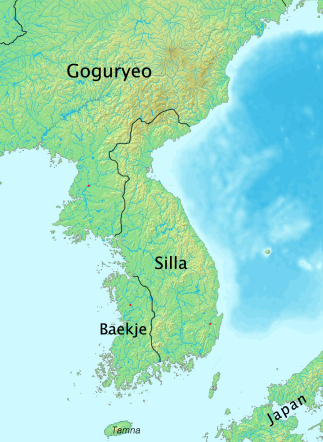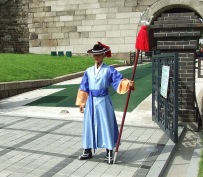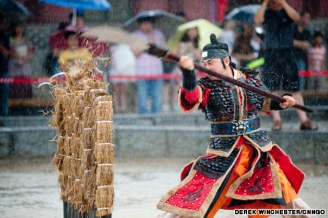
History ( Yuk Sa )
Korean Martial Arts are made up of three distinct, ancient fighting arts. Those arts are
Sado Mu Sool or Family martial art
Kung Jung Mu Sool or Royal martial art
Bul Gyo Mu Sool or Buddhist martial art

The ancient Korean kingdom of Goguryeo which ruled over eastern Asia included the Korea Penindula and Manchuria. Gorguryeo generals and warriors fought historic battles along the Korea peninsula and in neighboring countries to defend and expand their vast territory.
In AD 372 Buddhism was etablished in Silla, Korea and these days, many Buddhist/ Taoist monks practiced martial arts and shared their ideas and techniques across cultural borders. The conerstones of Jangmookido system are based on the Buddhist monk's unique training methods and philosophy of life. The true principles of Jangmookido are:
should be able to master yourself with perfection "
One of the main weapons the Baekje Royal army was Gakgung, rain of arrows that darkens the bright sky, dims down like a shower of hail, then it was just a matter of going in and clearing with swords and spears. The armor worn by there warriors symbolizes their strength, agility and determination. They protected them in violent epic spreads and led them to victory.
Ancient battles were originally structured around the use of weapons, not emty hands, because weapons, such as sword and staff, were more efficient in fight than just bare hands. Since ancient battles (martial arts) were based on life and death combat situations, an important part of any master of battle skill was the ability to keep using his weapon, no matter how the fighting condition's changed.
Notes of long pole weapons from that time...
Sado Mu Sool
means family, clan or tribal martial arts. As this was maily passed down from one generation to next through family line. It is probably not possibly to find the history behind the longstaff or its source because of its simplicity and easy access. The roots of Jangmookido date back to the very beginning of Korea (2333B.C. Dan Kun). The bong (pole) was orginally weapon of Sado Mu Sool, used for hunting and as a defensive weapons to make with the building matrial growing the forests around the villages. The Bong was mainly preferred by the people in rural area, as the peasants could not afford sword weapons. But a Bong was quickly at hand when danger arose.
During later the tribal commune period, young warriors gradually engaged in more systematic martial arts training; thus they could carry out more efficient hunting and defense against neighboring tribals. You think that styles like, Teakkyon, Subak and Ssireum; began its development then. Weapon training included the practice of Dolkal (stone knife), Dolchang (stone spear) Doldunjiki (stone throwing), Moraisul (sand spreading), Whal (archery), and Mok bong (wooden pole) with one end angled into a point, to make it more efficient. The employment of horseback riding greatly challenged the lifestyles of later tribals.
Bul Gyo Mu Sool
are the unique skills developed by Korean Buddhist Monks. In his travels spread his religion. The monk Bodhid Dharma recognized that many hours of sitting in quiet meditation created a need for some form of exercise to maintain healht. That's how it Buddhist martial arts came about. A presentation of some of the Bul Gyo Mu Sool weapons arsenal, The monks bongs (poles) existed in various guises...
The Jung bong, Middle staff was a favorite weapon for monks or pilgrims. The monks often used a staff as a means to carry things, such as a bundle of clothing, on their journeys. The Jung bong made a practical and handy weapon for the monks, who developed very sophisticated fighting methods and great expertise with this weapon. The Jung bong was a weapon of choice by the monks as it was readily available and allowed them to submit their enenies without killing them.
The Dan Bong, the Short staff (0,30m) as it's called in Korean, decended from the drumsticks that Buddhist monks used-and still use-to beat the large drums that sit in every temple in the nation. In old days, the priest would pound the instrument for prayer services and during emergencies when an alarm needed to be sounded in the monastery. Use of the drumsticks for self-defence become popular in the Korea's Koryo dynasty, which lasted from 935 - 1392. Policeman weapon, The effectiveness of the weapon enabled law-enforcement officers to neutralize any advantages without inflicting mortal injuries. Even today, the Dan Bong is considered a highly effective self-defense weapon.
Sam Jeul Bong, the Three Section Rod is a exercise weapon for the monks.
Bul Gyu Chang, Monk Spear was very effective weapons for the elite warrior monks.
Bi (cheon) Bong, the Sweep Broom Stick is a hidden weapon of the monks. When the monks cleaned up (leaf) in the garden in the temple, when the danger was there so...
Ji Pang Ee, the Cane was a defensive weapon of the monk. The cane is considered by many to be a gentleman's weapon. One of the benefits of learning these techniques is they can easily be converted to use with a long umbrella or even a short stick. In ancient time, The Royal Court used cane also, a small sword would be hidden inside the body of the cane, or small blades dipped in poison might be insterted in the tip of the cane. Today's Jangmookido cane techniques are combination of Buddhist and Royal Court martial arts, using many self-defense and submission techniques.
Kuk Gung Sool, the Archery is a meditation weapon for the monks, and is the national coat of arms of Korea.
Kung Jung Mu Sool
It was during The Three Kingdoms period that two notable warrior classes developed: Sun Bi (intelligent-brave) and later Hwa Rang (youthful-flower). Besides being warriors, they are said to have established a high moral code of conduct and were schooled in the intellectual and cultural arts of the time...
Here some of their most interesting
long pole weapons are descibed:
CHANG - Spear
The different lengths usually distinguished the chang, for example the long spear (Jang Chang) was a horseman's weapon and usually made from hardwood, while the shorter more supple bamboo spear (jook jang chang) was a favourite with regular foot solider. This type of spear was generally shorter, lighter, flexible, and a more manoeuvrable weapon for the battlefield. A shorter spear, mostly carrying the army's colours in the form of a flag spear (ki chang), which could also be adapted and used as a fighting implement as well. The three-pointed spear (Dang pa), the middle tip would always be longer than the other two. This design was intended to reduce the risk of the weapon becoming lodged in the opponent's body. Dang pa was effective in battle because it could block and lock opponent's weapons and also fell horsmen.
The traditional Korean spear could be used in several different ways; with its sharpened metal tip it could be used in a cutting or diagonal slicing motion. The opposite end had similar use to that of a staff and of course spears had the added advantage of being able to be thrown. The advantage of having a spear as opposed to using a sword was that it did add considerable distance between a warrior and his opponent. The spear with it's red dyed horsehair at the end of the metal section was used to soak up blood so didn't run down the pole making the worriors hands become slippery. The red horsehair was also used as of distraction, disorientating an opponent with circular movements in front of their face.
Woldo (halbard) is a weapon named after the crescent-sharped blade and similar to the Chinese equivalent of the weapon, better known as the Guando. This sword-staff was a fearsome weapon that was difficult to handle, due to its size. Only the best elite soldiers could wield it, and even from horseback in battle.
Hyeopdo, (spear sword pole)
Pyeongbong, (long sledgehammer)
International Jangmookido Federation was officially formed in 2017 to pread the spirit of Jangmookido to the world. Jangmookido is based on more than one thousand five handred years of Korean history and has been researched and developed by master Jonny Edvinsson to create a comprehensive and spectacular martial art of traditional Korean long pole weapons. The purpose of Jangmookido is to allow people to have the opportunity to practice a modern sport of an ancient art of battle.



